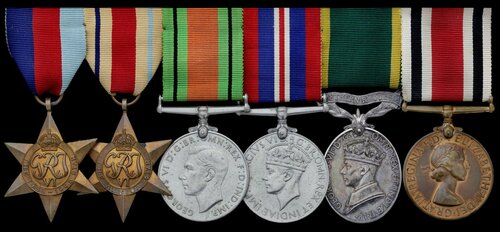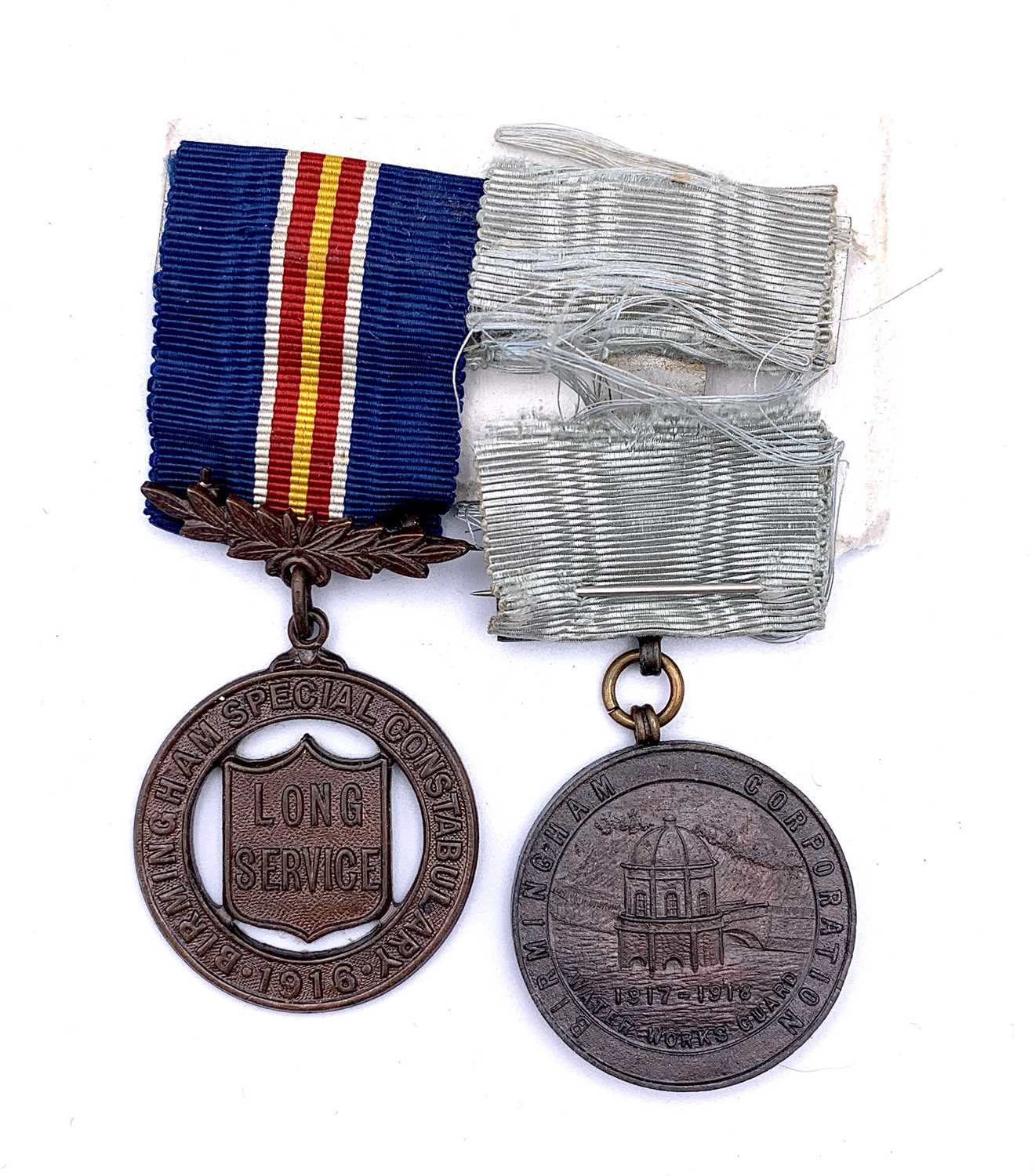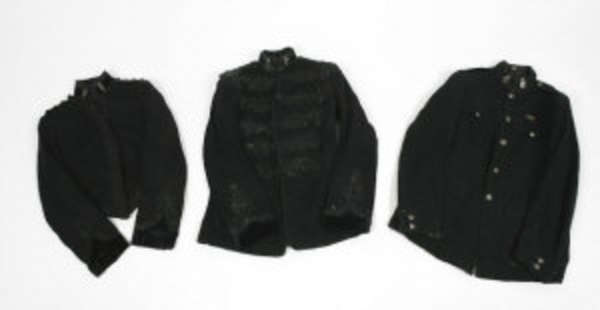The unusual 1920 Constabulary Medal (Ireland) Pair awarded to Special Constable C. Clarke, Royal Irish Constabulary, a re-engaged veteran Peeler whose R.I.C. service had begun in 1886, for his gallantry when Clara Barracks was isolated, surrounded, and attacked by over 200 men; the I.R.A. units in co. Offaly suffered a bloody reverse at the hands of the police garrison. In spring 1921, while on leave at his family home in Westmeath, Clarke was targeted to be abducted and executed, but he managed to outwit his would-be assassins and served on until the R.I.C. was disbanded Constabulary Medal (Ireland), 2nd type, ‘Reward of Merit Royal Irish Constabulary’ (Special Constable Charles Clarke 52192. 1920.) lacking integral top silver riband bar; Visit to Ireland 1900 (C. C. Clarke. R.I.C.) with integral top shamrock suspension bar, minor edge bruising, very fine (2) £2,800-£3,200 Footnote Constabulary Medal awarded 14 July 1920. Charles Clarke was born in Mullagh, co. Cavan, in December 1864 or January 1865. After working as a farmer, he joined the Royal Irish Constabulary on 15 October 1886 and served as a Constable with the Sligo Police from 27 February 1887. Within four months, Clarke had received a Favourable Record. In 1893 he was transferred to Westmeath, six weeks before he married a Sligo girl. The fate of his first wife is not known, but (as Clarke was Catholic) it is most probable that she died, because on 30 October 1899 he married again, to Mary, a local girl, who was the same age as Clarke. The 1901 census records the couple and their one year-old son John Joseph as residing at the R.I.C. barracks at Fore, near Castlepollard, co. Westmeath. Clarke retired from the Peelers on 16 January 1907, taking his pension after 20 years of service. By the time of the 1911 census he was living at House 9, The Fore (Fore West). He was recorded as pensioner, R.I.C. and bacon agent, while Mary worked as a teacher at the local National School. Although they had two incomes, their house was described in 1921 as a modest ‘labourer’s cottage’. Their family had expanded to five children, three boys and two girls, aged between ten and one. Unusually, Clarke decided to re-engage in the R.I.C., under the provisions of the 1914 Special Constables Act (while retaining his pension). The workload of the R.I.C. had expanded dramatically from the moment war broke out, and the Inspector-General was happy to authorise districts to bring back a few trained and experienced men with excellent records of service, as a practical solution to cope with this challenge. At least one other retired Peeler (Hannon) who lived near Clarke, also rejoined the R.I.C. Clarke could have resigned at any time without losing his pension. He did not do so, although the Republicans began a sustained campaign of ostracism and intimidation against Peelers and their families, and the British government tabled legislation in 1918 to extend conscription to Ireland (had conscription begun, Clarke’s eldest son, John Joseph, would likely have been called up for overseas military service). In June 1920, Clarke was stationed in the R.I.C. barracks at Clara, about 3-4 hours bicycle ride (depending on the weather) from Fore. The republican campaign against the R.I.C. was at its height. The Peelers had evacuated around 400 of their smaller outstations. British army engineers had fortified the remainder with steel shutters and loopholes over their windows, piled sandbags and armoured doors. Word had been sent out to local I.R.A. units that they should attack and eliminate the remaining operational R.I.C. barracks in their districts. The attack on the Clara Barracks, 2-3 June 1920 The first large-scale attack in Offaly targeted Clara Barracks, a stone-built, slate-roofed, two storey, fortified structure on the main street of the town, sandwiched between Goodbody’s flour mill at one end and, at the other, a house which was the living quarters of the family of Sergeant Somers, who commanded
The unusual 1920 Constabulary Medal (Ireland) Pair awarded to Special Constable C. Clarke, Royal Irish Constabulary, a re-engaged veteran Peeler whose R.I.C. service had begun in 1886, for his gallantry when Clara Barracks was isolated, surrounded, and attacked by over 200 men; the I.R.A. units in co. Offaly suffered a bloody reverse at the hands of the police garrison. In spring 1921, while on leave at his family home in Westmeath, Clarke was targeted to be abducted and executed, but he managed to outwit his would-be assassins and served on until the R.I.C. was disbanded Constabulary Medal (Ireland), 2nd type, ‘Reward of Merit Royal Irish Constabulary’ (Special Constable Charles Clarke 52192. 1920.) lacking integral top silver riband bar; Visit to Ireland 1900 (C. C. Clarke. R.I.C.) with integral top shamrock suspension bar, minor edge bruising, very fine (2) £2,800-£3,200 Footnote Constabulary Medal awarded 14 July 1920. Charles Clarke was born in Mullagh, co. Cavan, in December 1864 or January 1865. After working as a farmer, he joined the Royal Irish Constabulary on 15 October 1886 and served as a Constable with the Sligo Police from 27 February 1887. Within four months, Clarke had received a Favourable Record. In 1893 he was transferred to Westmeath, six weeks before he married a Sligo girl. The fate of his first wife is not known, but (as Clarke was Catholic) it is most probable that she died, because on 30 October 1899 he married again, to Mary, a local girl, who was the same age as Clarke. The 1901 census records the couple and their one year-old son John Joseph as residing at the R.I.C. barracks at Fore, near Castlepollard, co. Westmeath. Clarke retired from the Peelers on 16 January 1907, taking his pension after 20 years of service. By the time of the 1911 census he was living at House 9, The Fore (Fore West). He was recorded as pensioner, R.I.C. and bacon agent, while Mary worked as a teacher at the local National School. Although they had two incomes, their house was described in 1921 as a modest ‘labourer’s cottage’. Their family had expanded to five children, three boys and two girls, aged between ten and one. Unusually, Clarke decided to re-engage in the R.I.C., under the provisions of the 1914 Special Constables Act (while retaining his pension). The workload of the R.I.C. had expanded dramatically from the moment war broke out, and the Inspector-General was happy to authorise districts to bring back a few trained and experienced men with excellent records of service, as a practical solution to cope with this challenge. At least one other retired Peeler (Hannon) who lived near Clarke, also rejoined the R.I.C. Clarke could have resigned at any time without losing his pension. He did not do so, although the Republicans began a sustained campaign of ostracism and intimidation against Peelers and their families, and the British government tabled legislation in 1918 to extend conscription to Ireland (had conscription begun, Clarke’s eldest son, John Joseph, would likely have been called up for overseas military service). In June 1920, Clarke was stationed in the R.I.C. barracks at Clara, about 3-4 hours bicycle ride (depending on the weather) from Fore. The republican campaign against the R.I.C. was at its height. The Peelers had evacuated around 400 of their smaller outstations. British army engineers had fortified the remainder with steel shutters and loopholes over their windows, piled sandbags and armoured doors. Word had been sent out to local I.R.A. units that they should attack and eliminate the remaining operational R.I.C. barracks in their districts. The attack on the Clara Barracks, 2-3 June 1920 The first large-scale attack in Offaly targeted Clara Barracks, a stone-built, slate-roofed, two storey, fortified structure on the main street of the town, sandwiched between Goodbody’s flour mill at one end and, at the other, a house which was the living quarters of the family of Sergeant Somers, who commanded

/46244/Internet%20Image%201.jpg)






/121336/Internet%20Image%201.jpg)
/119750/Internet%20Image%201.jpg)
/68824/Internet%20Image%201.jpg)

Testen Sie LotSearch und seine Premium-Features 7 Tage - ohne Kosten!
Lassen Sie sich automatisch über neue Objekte in kommenden Auktionen benachrichtigen.
Suchauftrag anlegen